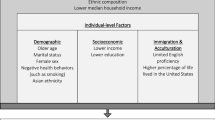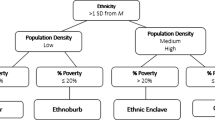Abstract
Ethnic enclaves may be protective for health. This study investigates the effects of neighborhood co-ethnic density on problem drinking among older Mexican American men. Probability sample of 2,086 community-dwelling Mexican Americans aged 75 or older drawn in 2004–2005 residing in communities in Arizona, California, Colorado, New Mexico and Texas. Problem drinking was found among 15.3 % of men (n = 350). For each percent increase in neighborhood percent Mexican American, men had 2 % lower odds of problem drinking [odds ratio (OR) 0.98; P < 0.05]. U.S. born men had lower odds of problem drinking (OR 0.40; P < 0.05) compared with foreign born men, while English language use was associated with greater odds of problem drinking (OR 2.14; P < 0.05). Older Mexican American men in neighborhoods with low levels of co-ethnic density, the foreign born, and those with English language facility had an increased likelihood of problem drinking.
Similar content being viewed by others
References
Markides KS, Coreil J. The health of Hispanics in the Southwestern United States: an epidemiologic paradox. Public Health Rep. 1986;101:253–65.
Franzini L, Ribble JC, Keddie A. Understanding the Hispanic paradox. Ethn Dis. 2001;11:496–518.
Hummer RA, Powers DA, Pullum SG, Gossman GL, Frisbie WP. Paradox found (again): infant mortality among the Mexican-origin population in the United States. Demography. 2007;44:441–57.
Eschbach K, Ostir GV, Patel KV, Markides KS, Goodwin JS. Neighborhood context and mortality among older Mexican Americans: is there a barrio advantage? Am J Public Health. 2004;94:1807–12.
Cuijpers P, Riper H, Lemmers L. The effects on mortality of brief interventions for problem drinking: a meta-analysis. Addiction. 2004;99:839–45.
Caetano R, Baruah J, Chartier K. Ten year trends (1992–2002) in sociodemographic predictors and indicators of alcohol abuse and dependence among whites, blacks, and Hispanics in the US. Alcohol Clin Exp Res. 2011;35:1458–66.
Markides KS, Al Snih S, Walsh T, Cutchin M, Ju H, Goodwin JS. Problem drinking among Mexican Americans: the influence of nativity and neighborhood context? Am J Health Promot AJHP [Internet] 2012 [cited 2014 Mar 11]; 26. http://www.ncbi.nlm.nih.gov/pmc/articles/PMC3856664/.
Satre DD, Gordon NP, Weisner C. Alcohol consumption, medical conditions, and health behavior in older adults. Am J Health Behav. 2007;31:238–48.
Bryant AN, Kim G. The relation between acculturation and alcohol consumption patterns among older Asian and Hispanic immigrants. Aging Mental Health. 2013;17:147–56.
Worby PA, Organista KC. Alcohol use and problem drinking among male Mexican and Central American im/migrant laborers a review of the literature. Hisp J Behav Sci. 2007;29:413–55.
Zemore SE. Acculturation and alcohol among Latino adults in the United States: a comprehensive review. Alcohol Clin Exp Res. 2007;31:1968–90.
Markides KS, Al Snih S, Walsh T, Cutchin M, Ju H, Goodwin JS. Problem drinking among Mexican-Americans: the influence of nativity and neighborhood context? Am J Health Promot. 2012;26:225–9.
Ewing JA. Detecting alcoholism: the CAGE questionnaire. JAMA. 1984;252:1905–7.
National Institute on Aging. Established populations for epidemiologic studies of the elderly: resource data book. Bethesda, MN: National Institute on Aging; 1986.
Wykle ML, Ford A. The health of Mexican American elderly: selected findings from the Hispanic EPESE. Serv Minor Elders 21st Century. New York: Springer Publishing Company; 1999. p. 25–36.
Markides KS, Miranda M, editors. Minorities, aging, and health. Thousand Oaks, CA: SAGE; 1997.
National Archive of Computerized Data on Aging [Internet]. 2014. doi:10.3886/ICPSR02851.v2.
National Archive of Computerized Data on Aging [Internet]. 2013. doi:10.3886/ICPSR25041.v1.
US Bureau of the Census Geography Division. Geographic Areas Reference Manual [Internet]. Washington, DC: U.S. Census Bureau; 1994 [cited 2013 Jul 25]. http://www.census.gov/geo/reference/pdfs/GARM/Ch10GARM.pdf.
US Bureau of the Census. Public Use Microdata Sample United States: Technical Documentation [Internet]. Washington, DC: U.S. Census Bureau; 2003 [cited 2013 Aug 8]. http://www.census.gov.
Saitz R, Lepore MF, Sullivan LM, Amaro H, Samet JH. Alcohol abuse and dependence in Latinos living in the United States: validation of the cage (4 m) questions. Arch Intern Med. 1999;159:718–24.
Ricketts ER, Sawhill IV. Defining and measuring the underclass. J Policy Anal Manag. 1988;7:316–25.
South ST, Crowder KD. Escaping distressed neighborhoods: individual, community, and metropolitan influences. Am J Sociol. 1997;102:1040–84.
Ross CE, Mirowsky J. Neighborhood disadvantage, disorder, and health. J Health Soc Behav. 2001;42:258–76.
Gerst K, Miranda PY, Eschbach K, Sheffield KM, Peek MK, Markides KS. Protective neighborhoods: neighborhood proportion Mexican American and depressive symptoms among very old Mexican Americans. J Am Geriatr Soc. 2011;59:353–8.
Patel KV, Eschbach K, Rudkin LL, Peek MK, Markides KS. Neighborhood context and self-rated health in older Mexican Americans. Ann Epidemiol. 2003;13:620–8.
Black SA, Markides KS. Acculturation and alcohol consumption in Puerto Rican, Cuban-American, and Mexican-American women in the United States. Am J Public Health. 1993;83:890–3.
Barnes GM, Welte JW, Tidwell M-CO, Hoffman JH. Effects of neighborhood disadvantage on problem gambling and alcohol abuse. J Behav Addict. 2013;2:82–9.
Moore J, Pinderhughes R, editors. In the barrios: Latinos and the underclass debate. New York: Russell Sage Foundation; 1993.
Vélez-Ibáñez C. US Mexicans in the borderlands: being poor without the underclass. In: Moore J, Pinderhughes R, editors. In the barrios: Latinos and the underclass debate. New York: Russell Sage Foundation; 1993. p. 195–210.
Gilbert MJ. Mexican-Americans in California. In: Ames GM, Bennett LA, editors. The American experience with alcohol. New York: Springer; 1985. p. 255–77.
Verbrugge LM, Jette AM. The disablement process. Soc Sci Med. 1994;38:1–14.
Markides KS, Eschbach K. Aging, migration, and mortality: current status of research on the Hispanic paradox. J Gerontol B Psychol Sci Soc Sci. 2005;60:S68–75.
Al Ghatrif M, Markides KS, Kuo Y, Ray LA, Moore AA. The effect of prevalent cardiovascular conditions on the association between alcohol consumption and mortality among older Mexican American men. Ethn Dis. 2013;23:168–74.
Acknowledgments
The Hispanic Established Populations for the Epidemiologic Study of the Elderly was funded by the National Institute on Aging (Grant No. AG-10939). Thanks to Kushang V. Patel for comments on an earlier version of this manuscript and Shana Khan for assistance in preparing references.
Author information
Authors and Affiliations
Corresponding author
Rights and permissions
About this article
Cite this article
Stroope, S., Martinez, B.C., Eschbach, K. et al. Neighborhood Ethnic Composition and Problem Drinking Among Older Mexican American Men: Results from the Hispanic Established Populations for the Epidemiologic Study of the Elderly. J Immigrant Minority Health 17, 1055–1060 (2015). https://doi.org/10.1007/s10903-014-0033-8
Published:
Issue Date:
DOI: https://doi.org/10.1007/s10903-014-0033-8




